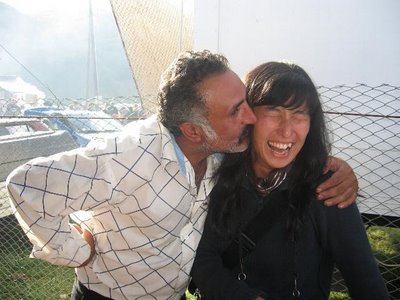 Honeyboy Edwards is, at 91 years old, essentially the last living representative of the pre-WWII Mississippi Delta blues scene. Edwards is credited with the original compostition of the classic "Sweet Home, Chicago." He was born in the same year as Robert Johnson and Muddy Waters, and in fact Honeyboy was with
Honeyboy Edwards is, at 91 years old, essentially the last living representative of the pre-WWII Mississippi Delta blues scene. Edwards is credited with the original compostition of the classic "Sweet Home, Chicago." He was born in the same year as Robert Johnson and Muddy Waters, and in fact Honeyboy was with  Robert Johnson on the night that Johnson drank the poisoned whiskey that killed him. Honeyboy learned a lot of what he knows from being around now legendary musicians like Charlie Patton, Son House, and Tommy Johnson. Since Aron has been listening to blues music all his life (he got the collected works of Robert Johnson for his tenth birthday, along with a bottleneck slide) I figured this might be his only chance to hear somebody from that older generation in person. When I was a kid learning guitar, I was lucky that people like the Rev. Gary Davis, Pink Anderson, and Brownie McGee were still making the rounds of folk festivals and clubs - they had a big influence on my guitar teachers and on me - I still mainly play in Piedmont style, rather than Delta. I once met the blues fiddler Howard "Louie Bluie"
Robert Johnson on the night that Johnson drank the poisoned whiskey that killed him. Honeyboy learned a lot of what he knows from being around now legendary musicians like Charlie Patton, Son House, and Tommy Johnson. Since Aron has been listening to blues music all his life (he got the collected works of Robert Johnson for his tenth birthday, along with a bottleneck slide) I figured this might be his only chance to hear somebody from that older generation in person. When I was a kid learning guitar, I was lucky that people like the Rev. Gary Davis, Pink Anderson, and Brownie McGee were still making the rounds of folk festivals and clubs - they had a big influence on my guitar teachers and on me - I still mainly play in Piedmont style, rather than Delta. I once met the blues fiddler Howard "Louie Bluie"  Armstrong and yes, at the age of 86 he could still speak Hungarian (Armstrong was raised in a West Virginia mining town among Polish and Hungarian kids. He could also speak Chinese...) When I was Aron's age I went to hear the Preservation Hall Jazz Band play at Lincoln Center, and went backstage to meet the musicians. They were pretty astounded to meet a kid at this show, and one very ancient gentleman offered me my very first sip of beer - Tom Robinson, who had played trombone in Buddy Bolden's Band and in the Eagle Band in New Orleans in the 1890s. Now, I've hung with some amazing musicians in my life - Fela Kuti, Lester Bowie, Dave Tarras, Bill Monroe, Dewey Balfa, Junior Murvin, Itzhak Perlman, to name a few - but getting your first beer from a member of Buddy Bolden's band is the kind of mojo that stamps you for life. You got to shake the hand that shook the hand... And Aron has been pretty serious learning guitar this last year, so we both had to go. This would be Aron's Mojo Bar Mitzvah...
Armstrong and yes, at the age of 86 he could still speak Hungarian (Armstrong was raised in a West Virginia mining town among Polish and Hungarian kids. He could also speak Chinese...) When I was Aron's age I went to hear the Preservation Hall Jazz Band play at Lincoln Center, and went backstage to meet the musicians. They were pretty astounded to meet a kid at this show, and one very ancient gentleman offered me my very first sip of beer - Tom Robinson, who had played trombone in Buddy Bolden's Band and in the Eagle Band in New Orleans in the 1890s. Now, I've hung with some amazing musicians in my life - Fela Kuti, Lester Bowie, Dave Tarras, Bill Monroe, Dewey Balfa, Junior Murvin, Itzhak Perlman, to name a few - but getting your first beer from a member of Buddy Bolden's band is the kind of mojo that stamps you for life. You got to shake the hand that shook the hand... And Aron has been pretty serious learning guitar this last year, so we both had to go. This would be Aron's Mojo Bar Mitzvah... I thought we would just pop in and be gone, but no. Honeyboy likes to talk. You put a 13 year old next to a 91 year old, and they talk... and talk... and talk.... Mr. Edwards is a real gentleman and a charmer. He reminisced about his father, a fiddler "Yeah, man he would push the bow... they would play songs like Corinna, they would dance them stomps...." and how he fared when he was on tour in Japan "They eat that fish, you know, like raw fish, I don't eat none of that. And all that chinee food - I don't eat no chinee food. So what we did, you see, we found us a store. They had hot dogs, they had bread, they had onions, we took that back to the hotel. They had a kitchen in the room, and we just cooked that and ate real good for three week, cause I don't eat none of that chinee food...." Boogie was also backstage, and had his guitar autographed by Honeyboy (he plays the same model Johnson Resonator as me...)
I thought we would just pop in and be gone, but no. Honeyboy likes to talk. You put a 13 year old next to a 91 year old, and they talk... and talk... and talk.... Mr. Edwards is a real gentleman and a charmer. He reminisced about his father, a fiddler "Yeah, man he would push the bow... they would play songs like Corinna, they would dance them stomps...." and how he fared when he was on tour in Japan "They eat that fish, you know, like raw fish, I don't eat none of that. And all that chinee food - I don't eat no chinee food. So what we did, you see, we found us a store. They had hot dogs, they had bread, they had onions, we took that back to the hotel. They had a kitchen in the room, and we just cooked that and ate real good for three week, cause I don't eat none of that chinee food...." Boogie was also backstage, and had his guitar autographed by Honeyboy (he plays the same model Johnson Resonator as me...) Gál "Boogie" Csaba has been playing traditional country blues guitar since way back - I met him in 1990 at the old Tilos az A, and played on one of his CDs with Dr. Walter's band. A couple of years ago, in what may be the most subversive use of Hungarian television in country blues history, Boogie entered the incredibly tacky Megasztar reality TV competition... and became one of the finalists. Overnight, people who never heard real blues were scarfing up his CDs - hardcore country blues all of them... Every time they aired the talent show concerts he's pull out his metal resonator guitar and blast out some incredible take on Kokomo Arold or Furry Lewis. It was wonderfully absurd. So Aron was pretty tickled to find out that the reality TV show star is another of Papa's old buddies. Wait til they hear about this at school!
Gál "Boogie" Csaba has been playing traditional country blues guitar since way back - I met him in 1990 at the old Tilos az A, and played on one of his CDs with Dr. Walter's band. A couple of years ago, in what may be the most subversive use of Hungarian television in country blues history, Boogie entered the incredibly tacky Megasztar reality TV competition... and became one of the finalists. Overnight, people who never heard real blues were scarfing up his CDs - hardcore country blues all of them... Every time they aired the talent show concerts he's pull out his metal resonator guitar and blast out some incredible take on Kokomo Arold or Furry Lewis. It was wonderfully absurd. So Aron was pretty tickled to find out that the reality TV show star is another of Papa's old buddies. Wait til they hear about this at school!
Friday, October 27, 2006
Shake the Hand that Shook the Hand
Tuesday, October 24, 2006
Some Maniac is Driving a Tank Outside the Burger King!...
 Yesterday was the 50th anniversary of the Hungarian Revolution of 1956. Normally, I would prefer to wax poetic about other features of Hungarian life, such as lángos or kolbász, but yesterday we in Budapest experienced another deeply Hungarian national cultural impulse - the uncontrollable urge to go batshit insane in the streets and throw things at policemen. As such, what should have been a solemn and dignified day of national unity and remembrance was turned into a politically inspired theatrical parody of the events of 1956. At dawn, police forced the demonstrators to leave the area around Kossuth ter, and subsequently found evidence that rather primitive weapons were being made in the tent city they had left behind. (Images from www.index.hu)
Yesterday was the 50th anniversary of the Hungarian Revolution of 1956. Normally, I would prefer to wax poetic about other features of Hungarian life, such as lángos or kolbász, but yesterday we in Budapest experienced another deeply Hungarian national cultural impulse - the uncontrollable urge to go batshit insane in the streets and throw things at policemen. As such, what should have been a solemn and dignified day of national unity and remembrance was turned into a politically inspired theatrical parody of the events of 1956. At dawn, police forced the demonstrators to leave the area around Kossuth ter, and subsequently found evidence that rather primitive weapons were being made in the tent city they had left behind. (Images from www.index.hu)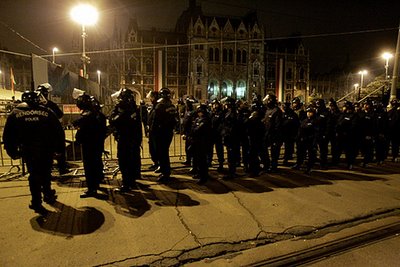 As previously mentioned, various right wing groups have spent the last month camping out in front of the Hungarian Parliament demanding the resignation of Prime Minister Ferenc Gyurcsány. It's a fascinating epic - Gyurcsány was caught on tape (secretly recorded at a closed session of the Hungarian Socialist Party soon after winning re-election last May) admitting that he lied about the economy in order to get elected. (In fairness, in the context of his speech he admonished his fellow party members that lying is not a good thing, and used rather salty language to get his point across.) Gyurcsány then further outraged Hungary's right wing by calling for, and then winning, a vote of confidence in the Parliament.
As previously mentioned, various right wing groups have spent the last month camping out in front of the Hungarian Parliament demanding the resignation of Prime Minister Ferenc Gyurcsány. It's a fascinating epic - Gyurcsány was caught on tape (secretly recorded at a closed session of the Hungarian Socialist Party soon after winning re-election last May) admitting that he lied about the economy in order to get elected. (In fairness, in the context of his speech he admonished his fellow party members that lying is not a good thing, and used rather salty language to get his point across.) Gyurcsány then further outraged Hungary's right wing by calling for, and then winning, a vote of confidence in the Parliament.  The demonstrators left the Kossuth ter area and fanned out through the downtown, first tanking up on beer at the Corvin Theater complex, and then eventually facing off with the police around downtown Deak square, about 500 meters away from the FIDESZ rally being held at Astoria square. As you can see, skinheads were in good supply for the days excitement. Where have these guys been hiding for the last few years, anyway? Skinheads versus Budapest police - my God, the combined IQ numbers may have reached the triple digits!
The demonstrators left the Kossuth ter area and fanned out through the downtown, first tanking up on beer at the Corvin Theater complex, and then eventually facing off with the police around downtown Deak square, about 500 meters away from the FIDESZ rally being held at Astoria square. As you can see, skinheads were in good supply for the days excitement. Where have these guys been hiding for the last few years, anyway? Skinheads versus Budapest police - my God, the combined IQ numbers may have reached the triple digits! Demonstrators were ordered to disperse, and when they defied the orders, the police went into riot mode, using water cannons and tear gas to disperse the crowd. Somebody commandeered a tank - on loan from a museum - jump-started it with car batteries and jumper cables and started driving it around. It didn't get far - it only had about a liter of fuel - but you can imagine the reaction of the cops. As we say in the States, they went postal... Things went downhill fast from there.
Demonstrators were ordered to disperse, and when they defied the orders, the police went into riot mode, using water cannons and tear gas to disperse the crowd. Somebody commandeered a tank - on loan from a museum - jump-started it with car batteries and jumper cables and started driving it around. It didn't get far - it only had about a liter of fuel - but you can imagine the reaction of the cops. As we say in the States, they went postal... Things went downhill fast from there.  Crowds chanted "56! 56!" in the streets, but there are some major differences. The 1956 revolt was against the secret police force of an appointed Communist party in the service of a foreign occupation army. The 2006 "revolt" was against the civil police force of a democratically elected government. One of the official demands made by the Kossuth tér protesters is that Fradi - the preffered footbal team of Hungary's right wing (they do Nazi salutes when they get a goal) - should be reinstated into Hungary's premier league after getting knocked down to the second division for financial mismanagement. That wasn't really an issue in 1956.
Crowds chanted "56! 56!" in the streets, but there are some major differences. The 1956 revolt was against the secret police force of an appointed Communist party in the service of a foreign occupation army. The 2006 "revolt" was against the civil police force of a democratically elected government. One of the official demands made by the Kossuth tér protesters is that Fradi - the preffered footbal team of Hungary's right wing (they do Nazi salutes when they get a goal) - should be reinstated into Hungary's premier league after getting knocked down to the second division for financial mismanagement. That wasn't really an issue in 1956.  The striped "Arpad Flag" again. The Hungarian web forums are very busy discussing what the striped flag actually means - but we all know it is the adopted symbol of the more severe right-wing skinhead and nationalist groups, and its use has become increasingly widespread since the September 18th attacks on the Magyar Television building. Soon the police and demonstrators were squared off at two main points - Blaha Lujza square and the road between Astoria square and the Erzsebet Bridge over the Danube.
The striped "Arpad Flag" again. The Hungarian web forums are very busy discussing what the striped flag actually means - but we all know it is the adopted symbol of the more severe right-wing skinhead and nationalist groups, and its use has become increasingly widespread since the September 18th attacks on the Magyar Television building. Soon the police and demonstrators were squared off at two main points - Blaha Lujza square and the road between Astoria square and the Erzsebet Bridge over the Danube.  The cops shot rubber bullets and tear gas at the crowd, who tossed the tear gas back at the police. It was angry and hateful, which is to say a relatively normal state of affairs in Hungary these days. Barricades were set up from construction materials and burning trash cans. The situation remained a standoff until dawn, when police used trucks to smash the barricades and the crowds dispersed.
The cops shot rubber bullets and tear gas at the crowd, who tossed the tear gas back at the police. It was angry and hateful, which is to say a relatively normal state of affairs in Hungary these days. Barricades were set up from construction materials and burning trash cans. The situation remained a standoff until dawn, when police used trucks to smash the barricades and the crowds dispersed.  Right now, the TV is full of talk shows analysing the situation, and as I listen now the shrill honking of Orban Viktor's voice is repeating his one-message-wonder speech about how Gyurcsány is a lying cheating bastid... but for a better sense of just how insane the world of political life is in Hungary, check out this article by Edward Lucas, the Central European correspondent for both the London Financial Times and the Economist. When he asks both FIDESZ and the Socialists about their economic plans, both parties gleefully admit that they lied to win elections. Its a hoot, but a sad one. About 150 injured - mostly demonstrators, many police as well. And more than ever, Hungarian popular opinion is divided and polarized beyond any hope of constructive dialog. Hungarians are attracted to all kinds of conspiracy theories - X sent secret provocateurs to set up Y, thus implicating Z - and the media is stocking up on some wild ones following yesterday's events.
Right now, the TV is full of talk shows analysing the situation, and as I listen now the shrill honking of Orban Viktor's voice is repeating his one-message-wonder speech about how Gyurcsány is a lying cheating bastid... but for a better sense of just how insane the world of political life is in Hungary, check out this article by Edward Lucas, the Central European correspondent for both the London Financial Times and the Economist. When he asks both FIDESZ and the Socialists about their economic plans, both parties gleefully admit that they lied to win elections. Its a hoot, but a sad one. About 150 injured - mostly demonstrators, many police as well. And more than ever, Hungarian popular opinion is divided and polarized beyond any hope of constructive dialog. Hungarians are attracted to all kinds of conspiracy theories - X sent secret provocateurs to set up Y, thus implicating Z - and the media is stocking up on some wild ones following yesterday's events.  Aron and I played it safe yesterday... we stayed home and watched Battlestar Galactica. Happier themes coming soon..... kajalás... chow time!
Aron and I played it safe yesterday... we stayed home and watched Battlestar Galactica. Happier themes coming soon..... kajalás... chow time!
Saturday, October 21, 2006
Pleskavica at Castro: 1956 gets derailed....
 One thing to notice is that these are not really Hungarian national flags. These are the red and white "Arpad Stripe" flags. Originally flown by the tenth century nomadic Hungarians, the Arpad Stripe was only revived as a symbol in 1944, under the Nazi Arrow Cross junta that took over Hungary after the German Nazis kidnapped Hungary's "not-right-wing-enough" regent Admiral Horthy. In the early 1990's skinhead groups revived the striped red flag. Very simply, flying it means the same as flying a swastika does in Germany.... The protest organizers set up a soup kitchen to attract the homeless, since there weren't enough demonstrators in the square during the day (each evening at 5 pm the FIDESZ party sends some politico to make speech, attacting a few thousand nominally normal earthlings.) Today, the Budapest police finally got the "National Council" to dismantle their tent city and leave the square so that the official 1956 ceremonies could take place with adequate security for the many international leaders of state who will be attending.
One thing to notice is that these are not really Hungarian national flags. These are the red and white "Arpad Stripe" flags. Originally flown by the tenth century nomadic Hungarians, the Arpad Stripe was only revived as a symbol in 1944, under the Nazi Arrow Cross junta that took over Hungary after the German Nazis kidnapped Hungary's "not-right-wing-enough" regent Admiral Horthy. In the early 1990's skinhead groups revived the striped red flag. Very simply, flying it means the same as flying a swastika does in Germany.... The protest organizers set up a soup kitchen to attract the homeless, since there weren't enough demonstrators in the square during the day (each evening at 5 pm the FIDESZ party sends some politico to make speech, attacting a few thousand nominally normal earthlings.) Today, the Budapest police finally got the "National Council" to dismantle their tent city and leave the square so that the official 1956 ceremonies could take place with adequate security for the many international leaders of state who will be attending.  Riding our bikes into the center of this neo-nazi rabble, I was hungry. A five minute bike ride from Kossuth tér brought us to Deák ter, and then it was a hop away to Madách ter... the new location of the Castro Bisztro. The Castro used to be on Radáy utca in the 9th district, but relocated to downtown about six months ago. If you are in downtown Pest and want good food, unpretentious atmosphere, and good Hungarian and Serbian grill chow, the Castro is the place. You eat well, drink your fill, and you won't go broke. Originally started by Dutch pub genius (and jazz trombonist) Hans Van Vliet, and concieved of as a Serbian/Voivodina style grill pub by chef Nenad Angelic, the Castro has survived the move very well. Now the kitchen is run by Nenad's able lieutenant Sinese, a true grill master... I had to have the pleskavica... the Serb take on a burger, and one of the world's best attempt's to attain burger heaven. .. (pleskavica was discussed earlier...)
Riding our bikes into the center of this neo-nazi rabble, I was hungry. A five minute bike ride from Kossuth tér brought us to Deák ter, and then it was a hop away to Madách ter... the new location of the Castro Bisztro. The Castro used to be on Radáy utca in the 9th district, but relocated to downtown about six months ago. If you are in downtown Pest and want good food, unpretentious atmosphere, and good Hungarian and Serbian grill chow, the Castro is the place. You eat well, drink your fill, and you won't go broke. Originally started by Dutch pub genius (and jazz trombonist) Hans Van Vliet, and concieved of as a Serbian/Voivodina style grill pub by chef Nenad Angelic, the Castro has survived the move very well. Now the kitchen is run by Nenad's able lieutenant Sinese, a true grill master... I had to have the pleskavica... the Serb take on a burger, and one of the world's best attempt's to attain burger heaven. .. (pleskavica was discussed earlier...)  The cevapcici and pleskavica at the Castro are the objects of a manical Serb obsession with ground-meat quality, a legacy of Nenad Angelic, former head chef (he's now opened the Kafana, on the corner of Sörház and Molnár utca in the downtown district V... more later...) . The meat - a mix of beef and lamb - is bought from a Hungarian-Serbian butcher who lives 30 kilometers north of Budapest in the vilage of Göd - Misibacsi (uncle Mike.) Misibacsi's family left Serbia in the 1600's... good Racka Srbi fleeing the Ottoman Turks. The only Serbian family in Göd, they still speak Serbian at home, and all the daughters are sent off to Serbia for University, and thus fated to marry Serbian boys and bring them home to sustain the miniscule but historically tenacious Serbian heritage of Göd. You want ground cevap meat, you go to Misibacsi. Then you take it, semi-freeze it, massage it for a half hour with soda bicarbonate and onions, and run it through strange meat-extruding machines to produce the fine ground meat that makes a cevap or pleskavica more than just a burger. Served in a fresh lepény bread (in Serbian or Croatian lepenje) with kaymak - the balkan version of creme fraiche, a step up from sour cream - and onions. The cooks here know me and they know I didn't want ajvar (pepper paste) on my pleska....
The cevapcici and pleskavica at the Castro are the objects of a manical Serb obsession with ground-meat quality, a legacy of Nenad Angelic, former head chef (he's now opened the Kafana, on the corner of Sörház and Molnár utca in the downtown district V... more later...) . The meat - a mix of beef and lamb - is bought from a Hungarian-Serbian butcher who lives 30 kilometers north of Budapest in the vilage of Göd - Misibacsi (uncle Mike.) Misibacsi's family left Serbia in the 1600's... good Racka Srbi fleeing the Ottoman Turks. The only Serbian family in Göd, they still speak Serbian at home, and all the daughters are sent off to Serbia for University, and thus fated to marry Serbian boys and bring them home to sustain the miniscule but historically tenacious Serbian heritage of Göd. You want ground cevap meat, you go to Misibacsi. Then you take it, semi-freeze it, massage it for a half hour with soda bicarbonate and onions, and run it through strange meat-extruding machines to produce the fine ground meat that makes a cevap or pleskavica more than just a burger. Served in a fresh lepény bread (in Serbian or Croatian lepenje) with kaymak - the balkan version of creme fraiche, a step up from sour cream - and onions. The cooks here know me and they know I didn't want ajvar (pepper paste) on my pleska....  If you know hamburgers in Budapest, you understand why I only eat burgeroid constructions at Castro... Budapest burgers are a very sad story. Take, for example , the Frici Bufé in Obuda... which we happened on earlier in the day. A classic snack bufé located next to the Hév metro stop, Fritzi doesn't really know whether he is serving food to people or livestock.
If you know hamburgers in Budapest, you understand why I only eat burgeroid constructions at Castro... Budapest burgers are a very sad story. Take, for example , the Frici Bufé in Obuda... which we happened on earlier in the day. A classic snack bufé located next to the Hév metro stop, Fritzi doesn't really know whether he is serving food to people or livestock.  The burgers. Oh my fracking Gods, the burgers.... Dry crumbly pork and bread crumbs. They sit under an infrared lamp for a few afternoon hours until some unfortunate bunkó- under the influence of our abundant and cheap red wine - thinks this is the best way to avoid Budapest's rising restaurant prices... nuke that baby in a microwave and the bread stays crisp for at least ten seconds...
The burgers. Oh my fracking Gods, the burgers.... Dry crumbly pork and bread crumbs. They sit under an infrared lamp for a few afternoon hours until some unfortunate bunkó- under the influence of our abundant and cheap red wine - thinks this is the best way to avoid Budapest's rising restaurant prices... nuke that baby in a microwave and the bread stays crisp for at least ten seconds...  In these cases, the best bet is anything besides a bufé hamburger... microwave kolbász, chicken, frikadeller style meatwads....
In these cases, the best bet is anything besides a bufé hamburger... microwave kolbász, chicken, frikadeller style meatwads....
Sunday, October 15, 2006
Vioară cu goarnă, or if Hendrix played fiddle....
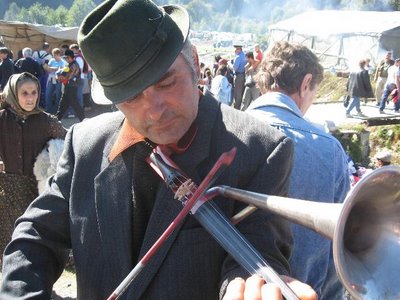 The vioară cu goarnă is the bastard child of the stroh violin, a hybrid resonator violin developed in the early 20th century in order to allow violins to be recorded by the primitive technology of early gramophone recording studios, which did a pretty bad job of recording violins. By setting a resonator (like those on a dobro or national guitar) under the violin bridge, the string vibration is carried to a metal or vinyl membrane, and then out through an attached horn, often butchered from an old bugle. They are made locally: here's Doctorul Pom Collins in Bratca examining the psychedelic white vioară cu goarnă that I bought from Mihaly Rostas last June:
The vioară cu goarnă is the bastard child of the stroh violin, a hybrid resonator violin developed in the early 20th century in order to allow violins to be recorded by the primitive technology of early gramophone recording studios, which did a pretty bad job of recording violins. By setting a resonator (like those on a dobro or national guitar) under the violin bridge, the string vibration is carried to a metal or vinyl membrane, and then out through an attached horn, often butchered from an old bugle. They are made locally: here's Doctorul Pom Collins in Bratca examining the psychedelic white vioară cu goarnă that I bought from Mihaly Rostas last June: The result is singularly loud and severely directional. If you stand in front of the fiddle, it sounds like Jimi Hendrix playing with feedback. If you are just off to the side you can hardly hear it, so the fiddlers swing their bodies around while playing, to get a wild wah-wah doppler effect. If you are behind the horn, as in playing it, you can barely hear it all. Mircea Rostas was at Negreni selling fiddles again, along with his wife and Traian Ardelean, one of the best Gypsy players. You could hear then a half a kilometer away.
The result is singularly loud and severely directional. If you stand in front of the fiddle, it sounds like Jimi Hendrix playing with feedback. If you are just off to the side you can hardly hear it, so the fiddlers swing their bodies around while playing, to get a wild wah-wah doppler effect. If you are behind the horn, as in playing it, you can barely hear it all. Mircea Rostas was at Negreni selling fiddles again, along with his wife and Traian Ardelean, one of the best Gypsy players. You could hear then a half a kilometer away. 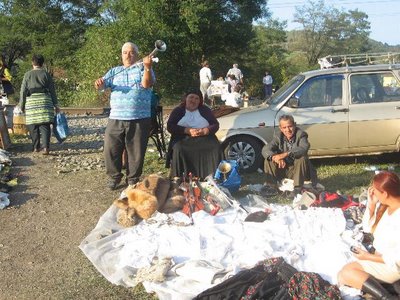 When played well it is the only fiddle that can overpower an accordion, sax, and drum band outdoors, without the help of any form of amplification.
When played well it is the only fiddle that can overpower an accordion, sax, and drum band outdoors, without the help of any form of amplification.  No one really knows how the stroh violin got to Romania, but legend has it that it was brought back by Romanian emigrants from north Dakota returning to Romania. In the 1930s the Great Depression was in full swing, and Romania was one of Europe's wealthiest economies, so a lot of Romanian immigrants came back, bringing the extremely loud stroh violins, and soon local musicians were copying them. Today, Dorel Cordoban from the village of Lazuri (near Rosia) is one of the best makers and players. He still prefers to tune his fiddles in the traditional local way - the G string, usually the lowest note on a violin, is replaced with an A string tuned up an octave to high G.
No one really knows how the stroh violin got to Romania, but legend has it that it was brought back by Romanian emigrants from north Dakota returning to Romania. In the 1930s the Great Depression was in full swing, and Romania was one of Europe's wealthiest economies, so a lot of Romanian immigrants came back, bringing the extremely loud stroh violins, and soon local musicians were copying them. Today, Dorel Cordoban from the village of Lazuri (near Rosia) is one of the best makers and players. He still prefers to tune his fiddles in the traditional local way - the G string, usually the lowest note on a violin, is replaced with an A string tuned up an octave to high G.  I've known Dorel and his family since 1990, when they were one of the first groups of Romanian folk musicians to play at the Hungarian National Dance House Festival, and they stayed at my apartment then and many other times afterwards. When Fumie first came to Romania with me, she bought her entire winter wardrobe from Dorel's wife Florica. They are a wonderful couple who really enjoy life and never travel without some of their best home-brewed plum brandy. In Bihor, pálinka accompanies every social event. As you can see, Florica is very proud of her pálinka.
I've known Dorel and his family since 1990, when they were one of the first groups of Romanian folk musicians to play at the Hungarian National Dance House Festival, and they stayed at my apartment then and many other times afterwards. When Fumie first came to Romania with me, she bought her entire winter wardrobe from Dorel's wife Florica. They are a wonderful couple who really enjoy life and never travel without some of their best home-brewed plum brandy. In Bihor, pálinka accompanies every social event. As you can see, Florica is very proud of her pálinka.  Dorel invited us to a local festival in Oradea the day after Negreni, and it turned into a huge parade of Bihor folk groups dancing around the city center, with Florica and Dorel and the villagers of Rosia leading the parade.
Dorel invited us to a local festival in Oradea the day after Negreni, and it turned into a huge parade of Bihor folk groups dancing around the city center, with Florica and Dorel and the villagers of Rosia leading the parade. 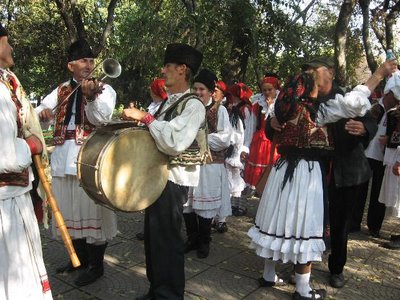 To hear the sound of the vioară cu goarnă try a few of these links (click on the link to go directly to MP3 media files.) From Prof. Robert Garfias' excellent Ethomusicology Kiosk Page there is a whole page about Bihor Music, including one cut on vioară cu goarnă, the Maruntel Din Valani. The Fono, a Hungarian cultural center, sponsored a series of Transylvanian village bands several years ago in the Utolso Ora Series ("Last Hour Series" reffering to the small amount of time left to hear such music. Their website is in Hungarian, but if you go to "terkép" and click on the map, you can eventually navigate your way into hours of Transylvanian traditional field recordings from all of Transylvania's ethnic groups.) They included some music played by Sumalan Stefan, from Halmosd, including a maruntelu, a classic învârtita and a jaunty schiopu. There is also a video RAM file of Jelu Covaci (who was also at the festival in Oradea) at the French world music magazine website, Mondomix.
To hear the sound of the vioară cu goarnă try a few of these links (click on the link to go directly to MP3 media files.) From Prof. Robert Garfias' excellent Ethomusicology Kiosk Page there is a whole page about Bihor Music, including one cut on vioară cu goarnă, the Maruntel Din Valani. The Fono, a Hungarian cultural center, sponsored a series of Transylvanian village bands several years ago in the Utolso Ora Series ("Last Hour Series" reffering to the small amount of time left to hear such music. Their website is in Hungarian, but if you go to "terkép" and click on the map, you can eventually navigate your way into hours of Transylvanian traditional field recordings from all of Transylvania's ethnic groups.) They included some music played by Sumalan Stefan, from Halmosd, including a maruntelu, a classic învârtita and a jaunty schiopu. There is also a video RAM file of Jelu Covaci (who was also at the festival in Oradea) at the French world music magazine website, Mondomix.
UPDATE (2.21.2007) Several short videos of vioara cu goarna being played by Ghica and Dorel can now be found on my Youtube page.
Thursday, October 12, 2006
Negreni II: Mici
 I'm not trying to slag off Romanian mici, but after a summer downing hundreds of of thumb sized ground beef and lamb fingerlings while in Turkey, I may now be lost to the pleasures of mici. Mici are much bigger than either köfte or cevapcici, and have less internal flavor. The meat used is usually beef neck meat mixed with some mutton - sheep, not lamb - and the grind is usually coarser. Apart from salt, the only spice is usually soda bicarbonate and charcoal smoke. A lot of charcoal smoke.
I'm not trying to slag off Romanian mici, but after a summer downing hundreds of of thumb sized ground beef and lamb fingerlings while in Turkey, I may now be lost to the pleasures of mici. Mici are much bigger than either köfte or cevapcici, and have less internal flavor. The meat used is usually beef neck meat mixed with some mutton - sheep, not lamb - and the grind is usually coarser. Apart from salt, the only spice is usually soda bicarbonate and charcoal smoke. A lot of charcoal smoke.  Mici are almost never eaten at home. They are the meat snack of beer gardens, market places, grill resturants, and cookouts. They are usually wolfed down with thick hunks of bread, bright yellow mustard, and a big halba of beer. And tsuica. And another tsuica. And another tsuica. And another tsuica....
Mici are almost never eaten at home. They are the meat snack of beer gardens, market places, grill resturants, and cookouts. They are usually wolfed down with thick hunks of bread, bright yellow mustard, and a big halba of beer. And tsuica. And another tsuica. And another tsuica. And another tsuica.... Of course, there are other things to eat - a lot of families, proud of their cooking skills simply set up a table and turn out Mama's home cooking. Stuffed cabbage sarmale is a favorite - and some of the best stuffed cabbage I have eaten has been here at the Negreni fair. And I have eaten a lot of stuffed cabbage in my time...
Of course, there are other things to eat - a lot of families, proud of their cooking skills simply set up a table and turn out Mama's home cooking. Stuffed cabbage sarmale is a favorite - and some of the best stuffed cabbage I have eaten has been here at the Negreni fair. And I have eaten a lot of stuffed cabbage in my time...  This year the ladies from the village of Szék (Sic in Romanian) maintained a catering tent of their own. Szék is an almost entirely Hungarian town - its a very big village - in the Mezöseg region east of Cluj, and women from Szék have carved out a niche as cooks for most of the larger weddings in the Mezöseg. Szék has the reputation of being an arch-conservative Hungarian village, and the women still maintain their traditional dress of red skirts and kerchiefs. Many still wear black head kerchiefs - in memory of the destruction of Szék during the Mongol invasions in 1243. Talk about holding a grudge! While Szék is a holdout of archaic Hungarian culture, they are a bit too self-conscious of it for my tastes, and have been so since the 1930s, actively playing a rather weak nationalist card to the Hungarian appetite for imagined "authentic folkore." To their credit, however, to this day they actually do manage to maintain a healthy local culture and folkore despite being the ideal of "authenticty" for the folkie scene in Budapest.
This year the ladies from the village of Szék (Sic in Romanian) maintained a catering tent of their own. Szék is an almost entirely Hungarian town - its a very big village - in the Mezöseg region east of Cluj, and women from Szék have carved out a niche as cooks for most of the larger weddings in the Mezöseg. Szék has the reputation of being an arch-conservative Hungarian village, and the women still maintain their traditional dress of red skirts and kerchiefs. Many still wear black head kerchiefs - in memory of the destruction of Szék during the Mongol invasions in 1243. Talk about holding a grudge! While Szék is a holdout of archaic Hungarian culture, they are a bit too self-conscious of it for my tastes, and have been so since the 1930s, actively playing a rather weak nationalist card to the Hungarian appetite for imagined "authentic folkore." To their credit, however, to this day they actually do manage to maintain a healthy local culture and folkore despite being the ideal of "authenticty" for the folkie scene in Budapest.  But enough of turdy meat sticks! Everybody is here for shopping! You've all seen the Malls of The Future: this is the Mall of the Not-Future! This is where you can buy stuff that museums want to buy, but don't know what size to get it in. How about some nice furry sheepskin shepherds' cloaks, for those drizzly days minding the flocks up in the Apuseni montains?
But enough of turdy meat sticks! Everybody is here for shopping! You've all seen the Malls of The Future: this is the Mall of the Not-Future! This is where you can buy stuff that museums want to buy, but don't know what size to get it in. How about some nice furry sheepskin shepherds' cloaks, for those drizzly days minding the flocks up in the Apuseni montains? Here we see a set of bima cloths from a destroyed synagogue that was located near Bucharest. They were being sold by some Gypsy dealers from near Bucharest who wanted Euro 200 for these. Now, honestly, a lot of locals came up to me, Mr. Jew, and told me how heart-breaking it was to see these items for sale sitting on the dusty ground... and you know, there is a lucrative market in theUS and Israel for old Jucaica like these. But damn... if these folks weren't selling them as antiques these cloths would have ended up in the city dump or incinerator anyways.
Here we see a set of bima cloths from a destroyed synagogue that was located near Bucharest. They were being sold by some Gypsy dealers from near Bucharest who wanted Euro 200 for these. Now, honestly, a lot of locals came up to me, Mr. Jew, and told me how heart-breaking it was to see these items for sale sitting on the dusty ground... and you know, there is a lucrative market in theUS and Israel for old Jucaica like these. But damn... if these folks weren't selling them as antiques these cloths would have ended up in the city dump or incinerator anyways.  Sometimes the antique sellers have an unsettling way of evoking history.... no, these aren't neo-nazis, but obviously some old Nazi died and they bought the crap from his estate, and here it is. I have no idea how much it costs. I didn't ask....be careful about what you leave behind you when you die...
Sometimes the antique sellers have an unsettling way of evoking history.... no, these aren't neo-nazis, but obviously some old Nazi died and they bought the crap from his estate, and here it is. I have no idea how much it costs. I didn't ask....be careful about what you leave behind you when you die... Most folks simply need to buy normal stuff... you know, like horse trappings for the family mare... none of that SUV gas guzzling here. Petrol costs money, and who needs to spend money for farm transport when hay is free?
Most folks simply need to buy normal stuff... you know, like horse trappings for the family mare... none of that SUV gas guzzling here. Petrol costs money, and who needs to spend money for farm transport when hay is free? Next post: The loudest noise that ever came out of anything looking something like a fiddle: Music in Bihor.
Next post: The loudest noise that ever came out of anything looking something like a fiddle: Music in Bihor. 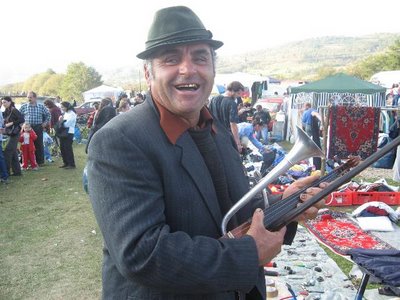
Tuesday, October 10, 2006
Negreni: "Excuse me, is your name Gabor?"
 Today, most of these fairs have become folklorized kitsch-fests. Only the Negreni fair – called the Fekete Tó Vásar (Black Lake Market) by the local Hungarian population – maintains its original function on such a huge scale. Each October thousands of Transylvanian peasants, Gypsies from all over Romania, and a few hundred curious tourists and antique dealers show up on the banks of the Cris River to bargain, buy, and beer away a weekend.
Today, most of these fairs have become folklorized kitsch-fests. Only the Negreni fair – called the Fekete Tó Vásar (Black Lake Market) by the local Hungarian population – maintains its original function on such a huge scale. Each October thousands of Transylvanian peasants, Gypsies from all over Romania, and a few hundred curious tourists and antique dealers show up on the banks of the Cris River to bargain, buy, and beer away a weekend.  Although Romania is set to join the EU in January 2007, the majority of Romanians live on incomes well below the EU poverty line, and have for a long time. Isolation under the Ceaucescu regime and subsequent lack of development had the effect of maintaining a rural culture in which people still made most of what they needed and used at home. In many villages, cash is rare commodity, and selling old clothes, peasant costumes, or antiques is an important way to make money.
Although Romania is set to join the EU in January 2007, the majority of Romanians live on incomes well below the EU poverty line, and have for a long time. Isolation under the Ceaucescu regime and subsequent lack of development had the effect of maintaining a rural culture in which people still made most of what they needed and used at home. In many villages, cash is rare commodity, and selling old clothes, peasant costumes, or antiques is an important way to make money.  While peasants live on what the land can provide, Gypsies live by what they can provide for those who own land. This woman is a Rudara, also known as the Lingurar, or spoon-makers. The Rom in Romania were held as slaves for 400 years, and during that time many, like the Rudari, lost the Romanes language and now speak only Romanian. I met a lot of them in Bulgaria, where they worked as dancing bear leaders, and in Hungary and Croatia, where they are called Baias - known in the US as Boyash Gypsies. These wooden troughs are used when pigs are killed to mix sausages.
While peasants live on what the land can provide, Gypsies live by what they can provide for those who own land. This woman is a Rudara, also known as the Lingurar, or spoon-makers. The Rom in Romania were held as slaves for 400 years, and during that time many, like the Rudari, lost the Romanes language and now speak only Romanian. I met a lot of them in Bulgaria, where they worked as dancing bear leaders, and in Hungary and Croatia, where they are called Baias - known in the US as Boyash Gypsies. These wooden troughs are used when pigs are killed to mix sausages.  Cauldron makers. You may not have seen these used on the Food Channel, but when you have to feed three hundred wedding guests or boil two pigs down into head cheese, you come to appreciate having a village of cauldron makers nearby. Most cauldron makers are from the Kalderash tribe, one of the most widespread groups in the Rom world.
Cauldron makers. You may not have seen these used on the Food Channel, but when you have to feed three hundred wedding guests or boil two pigs down into head cheese, you come to appreciate having a village of cauldron makers nearby. Most cauldron makers are from the Kalderash tribe, one of the most widespread groups in the Rom world. 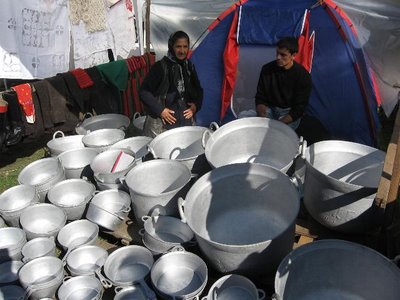 A Gabor Rom selling kazan. Kazan are stills used to distill plum brandy, known as tsuica in Romanian or pálinka in Hungarian. Nearly every well off peasant family brews their own, and Transylvanian pálinka is known for its strength – it is usually about 100 proof.
A Gabor Rom selling kazan. Kazan are stills used to distill plum brandy, known as tsuica in Romanian or pálinka in Hungarian. Nearly every well off peasant family brews their own, and Transylvanian pálinka is known for its strength – it is usually about 100 proof. 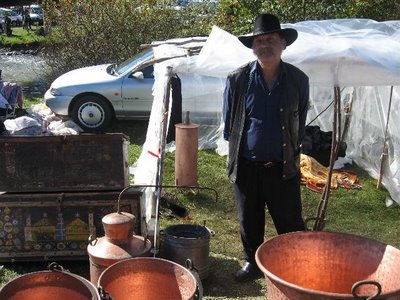 Transylvanians drink a lot of pálinka. A shot at breakfast usually starts the day, and shots accompany virtually all social occaisions. Pálinka is also considered a medicine. Got a stomach ulcer? Try pálinka mixed with honey. Bronchitis? Pálinka with herbs. You’re going to die anyway, so why not from pálinka…. it goes especially well with a breakfast of stuffed cabbage. Notice the clear liquid in the soda bottle on the table.. it is not water.
Transylvanians drink a lot of pálinka. A shot at breakfast usually starts the day, and shots accompany virtually all social occaisions. Pálinka is also considered a medicine. Got a stomach ulcer? Try pálinka mixed with honey. Bronchitis? Pálinka with herbs. You’re going to die anyway, so why not from pálinka…. it goes especially well with a breakfast of stuffed cabbage. Notice the clear liquid in the soda bottle on the table.. it is not water.  The Gaboresti are an offshoot of the Kalderash tribe that probably came under a heavy Saxon influence in the 19th century. Almost all of them are named "Gabor" - Janos Gabor, Rafael Gabor, and of course, Gabor Gabor. I once even met a woman named Gabriella Gabor Gaborné (Mrs. Gabor Gabriella Gabor.) Gaboresti occupy one of the highest rungs in the Rom status system, being quite well off from their occupations as market sellers everywhere around Europe. They are known for putting their profits into building huge homes for their large familes, with an emphasis on shiny steel filigree roofs, like these in Huedin (Bannfy-Hunyád in Hungarian) about fifteen kilometers south of Negreni.. "Gabor Palaces" seem to be in a perpetual state of construction.
The Gaboresti are an offshoot of the Kalderash tribe that probably came under a heavy Saxon influence in the 19th century. Almost all of them are named "Gabor" - Janos Gabor, Rafael Gabor, and of course, Gabor Gabor. I once even met a woman named Gabriella Gabor Gaborné (Mrs. Gabor Gabriella Gabor.) Gaboresti occupy one of the highest rungs in the Rom status system, being quite well off from their occupations as market sellers everywhere around Europe. They are known for putting their profits into building huge homes for their large familes, with an emphasis on shiny steel filigree roofs, like these in Huedin (Bannfy-Hunyád in Hungarian) about fifteen kilometers south of Negreni.. "Gabor Palaces" seem to be in a perpetual state of construction. 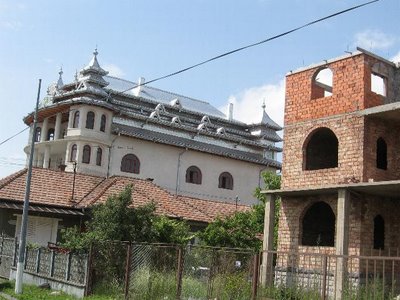 Negreni is one of the major meeting places for Transylvania’s large Roma population, and is a major social event where families reunite, feast, and party until dawn.
Negreni is one of the major meeting places for Transylvania’s large Roma population, and is a major social event where families reunite, feast, and party until dawn.  A lot of Transylvanian Gypsies are Seventh Day Adventists - especially among the Gabors and some musician families - who do not drink alchohol or eat pork. (Mind you - beer isn't considered alchohol by anybody except breathalizer test analysts anywhere in east Europe.) This is replaced with a sense of market capitalism that would make Marx spin in his grave. You name it, they sell it. Chef's knives and boxed sets of kitchen utensils are big Gabor items, and they do a brisk business in imported bed linens from Turkey.
A lot of Transylvanian Gypsies are Seventh Day Adventists - especially among the Gabors and some musician families - who do not drink alchohol or eat pork. (Mind you - beer isn't considered alchohol by anybody except breathalizer test analysts anywhere in east Europe.) This is replaced with a sense of market capitalism that would make Marx spin in his grave. You name it, they sell it. Chef's knives and boxed sets of kitchen utensils are big Gabor items, and they do a brisk business in imported bed linens from Turkey.  Their costume - immaculate colored skirts for women, black baggy pants and huge cowboy hats for men, black leather vests for both men and women - make them easy to spot. I've met Gabors in Budapest, Paris, Milan, and Istanbul. They look you straight in the eye, and if you are wearing a big enough hat, they shout out the greeting "Szervusz, Gabor!"
Their costume - immaculate colored skirts for women, black baggy pants and huge cowboy hats for men, black leather vests for both men and women - make them easy to spot. I've met Gabors in Budapest, Paris, Milan, and Istanbul. They look you straight in the eye, and if you are wearing a big enough hat, they shout out the greeting "Szervusz, Gabor!" 
While drinking a beer, one Gabor family sat down with us - this is direct marketing, remember - and eventually the wife of the family began to ask for money. Look, even Gabor Gypsies beg. The old man asked me "Won't you give something to help the poor Gabors?" I answered "Well, the Gabors aren't famous for being poor." The old guy looked around, cracked a smile, and said "Yes. You're right!" They are some of the friendliest people I have known in Transylvania.
